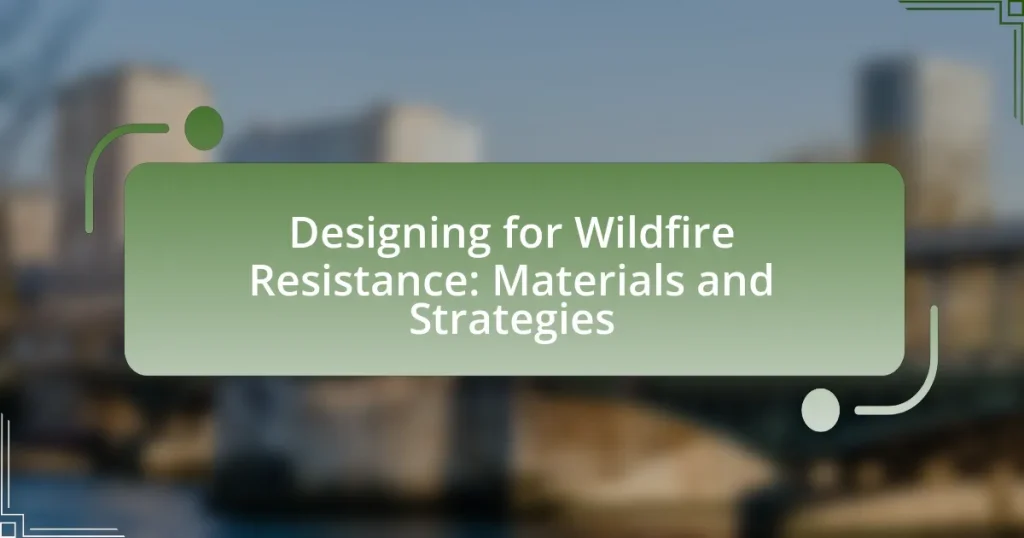Designing for wildfire resistance focuses on creating structures and landscapes that can withstand or mitigate the effects of wildfires. Key strategies include using fire-resistant materials such as stucco, brick, and metal, implementing defensible space around properties, and incorporating fire-resistant landscaping. The article outlines the importance of these design principles, the impact of environmental factors on material selection, and the role of local building codes in ensuring compliance. Additionally, it discusses the consequences of inadequate wildfire resistance and best practices for homeowners and builders to enhance safety and resilience against wildfires.

What is Designing for Wildfire Resistance?
Designing for wildfire resistance involves creating structures and landscapes that can withstand or mitigate the effects of wildfires. This approach includes using fire-resistant materials, implementing defensible space strategies, and incorporating design features that reduce the risk of ignition. For instance, materials such as stucco, brick, and metal are often recommended due to their lower flammability compared to wood. Additionally, maintaining a defensible space of at least 30 feet around a property can significantly decrease the likelihood of fire damage, as supported by guidelines from the National Fire Protection Association.
How does wildfire resistance impact building design?
Wildfire resistance significantly impacts building design by necessitating the use of fire-resistant materials and strategic architectural features. Buildings in wildfire-prone areas are often constructed with non-combustible materials such as stucco, brick, or metal, which can withstand high temperatures and prevent ignition. Additionally, design strategies like creating defensible space, using firebreaks, and incorporating ember-resistant vents are essential to minimize fire risk. Research from the National Institute of Standards and Technology indicates that homes built with these considerations can reduce fire damage by up to 80%, demonstrating the effectiveness of wildfire-resistant design in protecting structures from wildfires.
What are the key principles of wildfire-resistant design?
The key principles of wildfire-resistant design include the use of non-combustible materials, creating defensible space, and implementing fire-resistant landscaping. Non-combustible materials, such as stucco, brick, or metal, significantly reduce the risk of ignition from embers. Defensible space involves maintaining a buffer zone around structures by clearing flammable vegetation and debris, which can help slow the spread of fire. Fire-resistant landscaping incorporates plants that are less likely to ignite and arranging them to minimize fire risk. These principles are supported by guidelines from organizations like the National Fire Protection Association, which emphasize the importance of building materials and landscape management in reducing wildfire hazards.
How do environmental factors influence design choices?
Environmental factors significantly influence design choices by dictating the materials, structural features, and overall strategies employed in construction. For instance, in wildfire-prone areas, designers prioritize fire-resistant materials such as stucco, brick, or metal over wood to enhance safety and durability. Research from the National Institute of Standards and Technology indicates that homes built with non-combustible materials can reduce fire damage by up to 80%. Additionally, the layout of structures is often designed to create defensible space, minimizing vegetation that could fuel a fire. These considerations reflect a direct response to environmental risks, ensuring that design choices align with the need for resilience against wildfires.
Why is wildfire resistance important in construction?
Wildfire resistance is important in construction because it significantly reduces the risk of property damage and loss of life during wildfire events. Structures designed with fire-resistant materials and strategies can withstand extreme heat and flying embers, which are common in wildfires. According to the National Fire Protection Association, homes in wildfire-prone areas that incorporate fire-resistant features can reduce the likelihood of ignition by up to 80%. This proactive approach not only protects individual properties but also contributes to community resilience and safety in fire-prone regions.
What are the consequences of inadequate wildfire resistance?
Inadequate wildfire resistance leads to increased property damage, loss of life, and environmental degradation. Structures lacking proper fire-resistant materials are more susceptible to ignition, resulting in higher destruction rates during wildfires. For instance, the 2018 Camp Fire in California destroyed over 18,000 structures, highlighting the critical need for effective wildfire-resistant designs. Additionally, inadequate resistance can exacerbate air quality issues due to increased smoke and particulate matter from burning materials, impacting public health. The economic costs associated with rebuilding and recovery from such disasters can reach billions, as seen in the aftermath of major wildfires across the United States.
How can effective design mitigate wildfire risks?
Effective design can mitigate wildfire risks by incorporating fire-resistant materials and strategic landscaping. Utilizing non-combustible materials such as stucco, brick, or metal for building exteriors significantly reduces the likelihood of ignition from embers. Additionally, creating defensible space through proper vegetation management, such as maintaining a buffer zone of at least 30 feet around structures, minimizes fuel sources that can feed a fire. Research from the National Fire Protection Association indicates that homes in well-designed defensible spaces are 50% less likely to be damaged by wildfires compared to those without such measures.

What materials are best for wildfire-resistant design?
The best materials for wildfire-resistant design include non-combustible materials such as stucco, brick, concrete, and metal. These materials have been proven to withstand high temperatures and resist ignition from embers, which are a primary cause of wildfire damage. For instance, studies show that homes built with stucco or brick have a significantly lower risk of ignition compared to those with wood siding. Additionally, tempered glass windows and metal roofing further enhance fire resistance by preventing heat transfer and reducing the likelihood of breakage during a fire event.
What types of materials are considered fire-resistant?
Fire-resistant materials include concrete, brick, steel, and certain types of treated wood. These materials are designed to withstand high temperatures and resist ignition, making them suitable for construction in wildfire-prone areas. For instance, concrete and brick do not burn and can withstand extreme heat, while steel maintains structural integrity under fire conditions. Treated wood, when properly treated with fire retardants, can also provide enhanced fire resistance. According to the National Fire Protection Association, using these materials can significantly reduce the risk of fire damage in buildings located in vulnerable regions.
How do different materials perform under extreme heat?
Different materials exhibit varying degrees of performance under extreme heat, significantly impacting their suitability for wildfire resistance. For instance, metals like steel and aluminum can withstand high temperatures without losing structural integrity, with steel maintaining strength up to approximately 1,500°F. In contrast, wood ignites at around 400°F, making it less suitable for high-risk areas. Concrete and masonry materials can endure extreme heat, with concrete capable of withstanding temperatures exceeding 2,500°F without structural failure. Additionally, fire-resistant materials such as fiber cement and treated wood can enhance resistance, as they are designed to withstand higher temperatures and resist ignition. These performance characteristics are critical in designing structures that can endure wildfires effectively.
What are the benefits of using non-combustible materials?
The benefits of using non-combustible materials include enhanced fire safety, reduced risk of property damage, and improved structural integrity during wildfires. Non-combustible materials, such as concrete, brick, and steel, do not ignite or contribute to the spread of fire, which significantly lowers the likelihood of a structure catching fire in a wildfire-prone area. According to the National Fire Protection Association, buildings constructed with non-combustible materials can withstand higher temperatures and are less likely to collapse, providing better protection for occupants and reducing the overall economic impact of fire damage.
How do local building codes influence material selection?
Local building codes significantly influence material selection by establishing specific requirements for fire resistance, structural integrity, and safety standards. These codes dictate the types of materials that can be used in construction, particularly in areas prone to wildfires, where regulations may mandate the use of non-combustible materials such as stucco, brick, or metal roofing. For instance, the International Building Code (IBC) includes provisions that require fire-resistant materials in designated wildfire hazard zones, ensuring that structures can withstand extreme heat and prevent the spread of flames. Compliance with these codes not only enhances safety but also impacts the overall design and cost of construction projects in wildfire-prone regions.
What regulations should be considered for wildfire resistance?
Regulations that should be considered for wildfire resistance include building codes, land use planning regulations, and fire safety standards. Building codes often mandate the use of fire-resistant materials and construction techniques, such as non-combustible roofing and siding, to minimize fire spread. Land use planning regulations may restrict development in high-risk wildfire zones, ensuring that structures are not placed in areas prone to wildfires. Fire safety standards, such as those set by the National Fire Protection Association (NFPA), provide guidelines for defensible space around properties, which is crucial for reducing fire risk. These regulations collectively aim to enhance community resilience against wildfires and protect lives and property.
How can builders ensure compliance with these codes?
Builders can ensure compliance with wildfire resistance codes by adhering to established building standards and guidelines specific to fire safety. This includes using fire-resistant materials, such as non-combustible siding and roofing, and implementing defensible space strategies around structures to minimize fire risk. Compliance can be verified through regular inspections and obtaining necessary permits from local authorities, which often require adherence to codes set by organizations like the International Code Council. Additionally, builders should stay informed about updates to fire safety regulations and participate in training programs that focus on wildfire-resistant construction practices.

What strategies can enhance wildfire resistance in design?
Implementing non-combustible materials, creating defensible space, and designing for fire-resistant landscaping are effective strategies to enhance wildfire resistance in design. Non-combustible materials, such as stucco, brick, or metal, significantly reduce the risk of ignition from embers. Establishing a defensible space of at least 30 feet around structures minimizes fuel sources, thereby decreasing fire intensity. Additionally, incorporating fire-resistant landscaping techniques, such as using drought-resistant plants and maintaining proper spacing, further mitigates fire risk. These strategies are supported by research from the National Fire Protection Association, which emphasizes the importance of building materials and landscaping in wildfire-prone areas.
How can landscaping contribute to wildfire resistance?
Landscaping can contribute to wildfire resistance by creating defensible space around structures, which reduces the risk of fire spreading. This is achieved through strategic plant selection, spacing, and maintenance practices that minimize fuel loads. For instance, using fire-resistant plants, maintaining a distance of at least 30 feet between vegetation and structures, and regularly clearing dead leaves and debris can significantly lower fire intensity and prevent ignition. Research indicates that homes surrounded by well-maintained defensible spaces are 50% more likely to survive wildfires compared to those without such measures.
What are the best practices for defensible space around structures?
The best practices for defensible space around structures include creating a buffer zone that reduces fire risk by managing vegetation and materials. This involves maintaining a minimum of 30 feet of defensible space, where flammable materials are removed, and vegetation is thinned to create a separation between the structure and potential fire sources. Additionally, using non-combustible materials for landscaping, such as gravel or stone, and maintaining a well-watered area around the home can further enhance fire resistance. Research indicates that homes in areas with properly maintained defensible space are significantly less likely to be damaged during wildfires, as evidenced by studies from the National Fire Protection Association, which highlight the effectiveness of these practices in reducing fire intensity and spread.
How does vegetation management play a role in fire safety?
Vegetation management is crucial for fire safety as it reduces the amount of combustible material available to fuel wildfires. By strategically thinning trees, removing dead vegetation, and creating defensible space around structures, the likelihood of fire spread is significantly decreased. Studies have shown that areas with effective vegetation management practices experience fewer and less intense wildfires, as evidenced by research conducted by the U.S. Forest Service, which indicates that proper management can reduce fire intensity by up to 50%. This proactive approach not only protects ecosystems but also enhances community safety by minimizing the risk of catastrophic fire events.
What architectural features improve wildfire resistance?
Architectural features that improve wildfire resistance include non-combustible materials, defensible space, and fire-resistant roofing. Non-combustible materials, such as stucco, brick, or metal siding, significantly reduce the risk of ignition from embers. Defensible space, which involves creating a buffer zone around the structure by clearing flammable vegetation, enhances safety by limiting fire spread. Fire-resistant roofing materials, like tile or metal, can withstand high temperatures and prevent roof ignition. These features collectively contribute to a building’s ability to withstand wildfires, as evidenced by studies showing that homes with such characteristics are less likely to be damaged in wildfire events.
How do roof designs affect fire resistance?
Roof designs significantly affect fire resistance by influencing the materials used and the overall structure’s ability to withstand heat and flames. For instance, roofs constructed with non-combustible materials, such as metal or tile, provide better fire resistance compared to those made from wood or asphalt shingles, which are more flammable. According to the National Fire Protection Association, roofs with a Class A rating, indicating the highest level of fire resistance, can significantly reduce the risk of fire spread during wildfires. Additionally, the slope and shape of a roof can impact how embers accumulate; flat roofs may trap embers, while sloped roofs can allow them to roll off, reducing ignition potential. Therefore, thoughtful roof design incorporating fire-resistant materials and shapes is crucial for enhancing a building’s fire safety in wildfire-prone areas.
What role do windows and doors play in wildfire protection?
Windows and doors serve a critical role in wildfire protection by acting as barriers against heat, embers, and flames. Specifically, using tempered glass and non-combustible materials for windows can significantly reduce the risk of breakage and subsequent fire entry, as studies indicate that tempered glass can withstand higher temperatures compared to standard glass. Additionally, doors made from fire-resistant materials, such as steel or fiberglass, can prevent flames from penetrating the interior of a structure, thereby enhancing overall safety. Research from the National Institute of Standards and Technology shows that homes with properly designed windows and doors have a lower likelihood of ignition during wildfires, emphasizing their importance in wildfire-resistant design strategies.
What are the best practices for implementing wildfire-resistant design?
The best practices for implementing wildfire-resistant design include using non-combustible materials, creating defensible space, and incorporating fire-resistant landscaping. Non-combustible materials such as stucco, brick, or metal for exterior walls significantly reduce fire risk, as they do not ignite easily. Establishing a defensible space of at least 30 feet around structures minimizes fuel sources that can feed a fire, while maintaining a well-manicured landscape can further reduce fire spread. Additionally, using fire-resistant plants and maintaining proper spacing between vegetation can enhance safety. These practices are supported by guidelines from organizations like the National Fire Protection Association, which emphasize the importance of building materials and landscaping in wildfire-prone areas.
How can homeowners assess their property for wildfire risks?
Homeowners can assess their property for wildfire risks by conducting a thorough evaluation of their landscape, structures, and surrounding environment. This assessment includes identifying flammable vegetation within a 30-foot radius of the home, evaluating the condition of roofing materials, and checking for the presence of combustible materials near the foundation. According to the National Fire Protection Association, properties located in areas with dense vegetation or near wildland areas are at a higher risk, emphasizing the importance of maintaining defensible space and using fire-resistant building materials.
What steps should be taken during the construction process?
During the construction process for wildfire resistance, the primary steps include selecting appropriate materials, implementing defensible space, and ensuring proper building techniques. Selecting non-combustible or fire-resistant materials, such as stucco, brick, or metal roofing, significantly reduces fire risk. Implementing defensible space involves creating a buffer zone around the structure by clearing flammable vegetation and maintaining landscaping that minimizes fire spread. Proper building techniques, such as using dual-pane tempered glass windows and sealing gaps in siding, enhance the structure’s resilience against wildfires. These steps are supported by guidelines from organizations like the National Fire Protection Association, which emphasizes the importance of materials and design in wildfire-prone areas.




